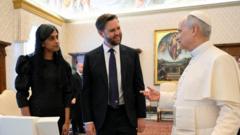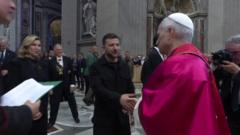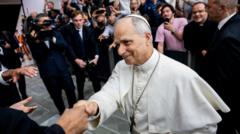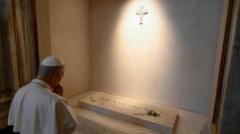As cardinals gather to elect a new pope, the iconic signaling of smoke colors from the Sistine Chapel chimney reveals the outcome to the world—white for a decision made, black for a deadlock, a tradition tracing back to the 19th century.
Black and White Smoke: The Vatican's Tradition of Pope Selection

Black and White Smoke: The Vatican's Tradition of Pope Selection
A look into the historic signaling method of the Vatican during papal elections and its evolution over the years.
Once the conclave of cardinals secludes itself in the Sistine Chapel to deliberate and vote on a new pope, the public's anticipation shifts towards the chimneys of the chapel, notably visible from St. Peter’s Square. The smoke emitted from this chimney serves a crucial role: it turns white if a new pope has been elected or black if the cardinals have not reached a two-thirds majority.
This tradition reportedly originated in the 19th century, with notable academic insights pointing to its early implementation during conclaves at the Quirinale Palace in Rome, which now serves as the Italian presidential residence. In Frederic J. Baumgartner's 2003 work "Behind Locked Doors," the earliest mention of colored smoke as a communication method dates back to 1823. Historically, while ballots were burned during earlier conclaves, there was no systematic effort to let the outside world know of a papal election's progress through visual signals like smoke.
The smoke itself is generated by burning the ballots and any notes the cardinals produce during their deliberations, using a cast-iron stove. Voting typically begins with one round on the first day, with subsequent days featuring four rounds—two each morning and afternoon. After each session, the undesirable ballots are incinerated, provided a pope hasn't been elected.
For much of the 20th century, to ensure the proper visual effect of white smoke, cardinals added wet straw to the stove, although this practice wasn't always consistent. An incident during the infamous 1958 conclave highlighted this, wherein the smoke appeared white twice in a single day, leading to widespread confusion among the public that a pope might have been elected when, in fact, no decision had been reached, demonstrating the challenges in signaling clarity through tradition.
This tradition reportedly originated in the 19th century, with notable academic insights pointing to its early implementation during conclaves at the Quirinale Palace in Rome, which now serves as the Italian presidential residence. In Frederic J. Baumgartner's 2003 work "Behind Locked Doors," the earliest mention of colored smoke as a communication method dates back to 1823. Historically, while ballots were burned during earlier conclaves, there was no systematic effort to let the outside world know of a papal election's progress through visual signals like smoke.
The smoke itself is generated by burning the ballots and any notes the cardinals produce during their deliberations, using a cast-iron stove. Voting typically begins with one round on the first day, with subsequent days featuring four rounds—two each morning and afternoon. After each session, the undesirable ballots are incinerated, provided a pope hasn't been elected.
For much of the 20th century, to ensure the proper visual effect of white smoke, cardinals added wet straw to the stove, although this practice wasn't always consistent. An incident during the infamous 1958 conclave highlighted this, wherein the smoke appeared white twice in a single day, leading to widespread confusion among the public that a pope might have been elected when, in fact, no decision had been reached, demonstrating the challenges in signaling clarity through tradition.




















